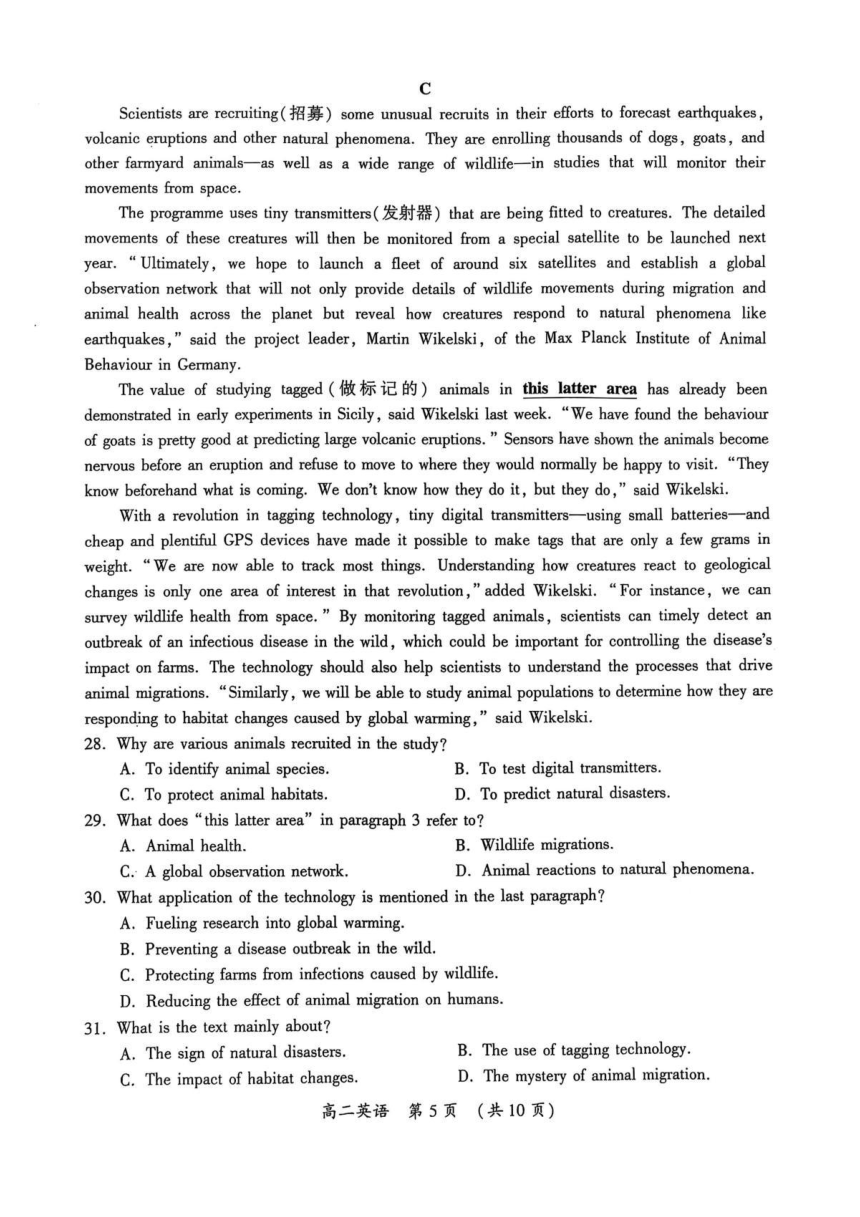河南省开封市2024-2025学年高二下学期期末考试英语试卷(PDF版,含答案,无听力原文及音频)
文档属性
| 名称 | 河南省开封市2024-2025学年高二下学期期末考试英语试卷(PDF版,含答案,无听力原文及音频) |  | |
| 格式 | docx | ||
| 文件大小 | 3.4MB | ||
| 资源类型 | 教案 | ||
| 版本资源 | 通用版 | ||
| 科目 | 英语 | ||
| 更新时间 | 2025-07-12 14:52:05 | ||
图片预览





文档简介
C
Scientists are recruiting()some unusual recruits in their efforts to forecast earthquakes,
volcanic eruptions and other natural phenomena.They are enrolling thousands of dogs,goats,and
other farmyard animals-as well as a wide range of wildlife-in studies that will monitor their
movements from space.
The programme uses tiny transmitters()that are being fitted to creatures.The detailed
movements of these creatures will then be monitored from a special satellite to be launched next
year."Ultimately,we hope to launch a fleet of around six satellites and establish a global
observation network that will not only provide details of wildlife movements during migration and
animal health across the planet but reveal how creatures respond to natural phenomena like
earthquakes,"said the project leader,Martin Wikelski,of the Max Planck Institute of Animal
Behaviour in Germany.
The value of studying tagged(做标记的)animals in this latter area has already been
demonstrated in early experiments in Sicily,said Wikelski last week."We have found the behaviour
of goats is pretty good at predicting large volcanic eruptions."Sensors have shown the animals become
nervous before an eruption and refuse to move to where they would normally be happy to visit."They
know beforehand what is coming.We don't know how they do it,but they do,"said Wikelski.
With a revolution in tagging technology,tiny digital transmitters-using small batteries-and
cheap and plentiful GPS devices have made it possible to make tags that are only a few grams in
weight."We are now able to track most things.Understanding how creatures react to geological
changes is only one area of interest in that revolution,"added Wikelski."For instance,we can
survey wildlife health from space."By monitoring tagged animals,scientists can timely detect an
outbreak of an infectious disease in the wild,which could be important for controlling the disease's
impact on farms.The technology should also help scientists to understand the processes that drive
animal migrations."Similarly,we will be able to study animal populations to determine how they are
responding to habitat changes caused by global warming,"said Wikelski.
28.Why are various animals recruited in the study
A.To identify animal species.
B.To test digital transmitters.
C.To protect animal habitats.
D.To predict natural disasters.
29.What does "this latter area"in paragraph 3 refer to
A.Animal health.
B.Wildlife migrations.
C.A global observation network.
D.Animal reactions to natural phenomena.
30.What application of the technology is mentioned in the last paragraph
A.Fueling research into global warming.
B.Preventing a disease outbreak in the wild.
C.Protecting farms from infections caused by wildlife.
D.Reducing the effect of animal migration on humans.
31.What is the text mainly about
A.The sign of natural disasters.
B.The use of tagging technology.
C.The impact of habitat changes.
D.The mystery of animal migration.
高二英语第5页(共10页)
CS扫描全能王
3亿
都在
扫描Ap
Scientists are recruiting()some unusual recruits in their efforts to forecast earthquakes,
volcanic eruptions and other natural phenomena.They are enrolling thousands of dogs,goats,and
other farmyard animals-as well as a wide range of wildlife-in studies that will monitor their
movements from space.
The programme uses tiny transmitters()that are being fitted to creatures.The detailed
movements of these creatures will then be monitored from a special satellite to be launched next
year."Ultimately,we hope to launch a fleet of around six satellites and establish a global
observation network that will not only provide details of wildlife movements during migration and
animal health across the planet but reveal how creatures respond to natural phenomena like
earthquakes,"said the project leader,Martin Wikelski,of the Max Planck Institute of Animal
Behaviour in Germany.
The value of studying tagged(做标记的)animals in this latter area has already been
demonstrated in early experiments in Sicily,said Wikelski last week."We have found the behaviour
of goats is pretty good at predicting large volcanic eruptions."Sensors have shown the animals become
nervous before an eruption and refuse to move to where they would normally be happy to visit."They
know beforehand what is coming.We don't know how they do it,but they do,"said Wikelski.
With a revolution in tagging technology,tiny digital transmitters-using small batteries-and
cheap and plentiful GPS devices have made it possible to make tags that are only a few grams in
weight."We are now able to track most things.Understanding how creatures react to geological
changes is only one area of interest in that revolution,"added Wikelski."For instance,we can
survey wildlife health from space."By monitoring tagged animals,scientists can timely detect an
outbreak of an infectious disease in the wild,which could be important for controlling the disease's
impact on farms.The technology should also help scientists to understand the processes that drive
animal migrations."Similarly,we will be able to study animal populations to determine how they are
responding to habitat changes caused by global warming,"said Wikelski.
28.Why are various animals recruited in the study
A.To identify animal species.
B.To test digital transmitters.
C.To protect animal habitats.
D.To predict natural disasters.
29.What does "this latter area"in paragraph 3 refer to
A.Animal health.
B.Wildlife migrations.
C.A global observation network.
D.Animal reactions to natural phenomena.
30.What application of the technology is mentioned in the last paragraph
A.Fueling research into global warming.
B.Preventing a disease outbreak in the wild.
C.Protecting farms from infections caused by wildlife.
D.Reducing the effect of animal migration on humans.
31.What is the text mainly about
A.The sign of natural disasters.
B.The use of tagging technology.
C.The impact of habitat changes.
D.The mystery of animal migration.
高二英语第5页(共10页)
CS扫描全能王
3亿
都在
扫描Ap
同课章节目录
